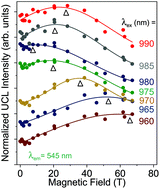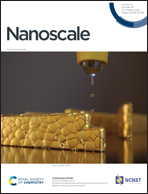Excitation efficiency determines the upconversion luminescence intensity of β-NaYF4:Er3+,Yb3+ nanoparticles in magnetic fields up to 70 T†
Abstract
Lanthanide-doped nanoparticles enable conversion of near-infrared photons to visible ones. This property is envisioned as a basis of a broad range of applications: from optoelectronics, via energy conversion, to bio-sensing and phototherapy. The spectrum of applications can be extended if magnetooptical properties of lanthanide dopants are well understood. However, at present, there are many conflicting reports on the influence of the magnetic field on the upconverted luminescence. In this work, we resolve this discrepancy by performing a comprehensive study of β-NaYF4:Er3+,Yb3+ nanoparticles. Crucially, we show that the magnetic field impacts the luminescence only via a Zeeman-driven detuning between the excitation laser and the absorption transition. On the other hand, the energy transfer and multiphonon relaxation rates are unaffected. We propose a phenomenological model, which qualitatively reproduces the experimental results. The presented results are expected to lead to design of novel, dual-mode opto-magnetic upconverting nanomaterials.

- This article is part of the themed collection: Singlet fission and photon upconversion


 Please wait while we load your content...
Please wait while we load your content...